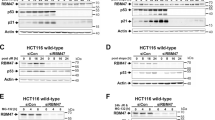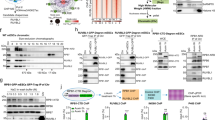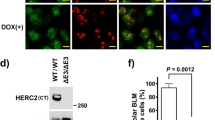Abstract
The nucleolar Arf protein has been shown to regulate cell cycle through both p53-dependent and -independent pathways. In addition to the well-characterized Arf-mdm2-p53 pathway, several partners of Arf have recently been described that could participate in alternative regulation process. Among those is the nucleolar protein B23/NPM, involved in the sequential maturation of rRNA. p19ARF can interact with B23/NPM in high molecular complexes and partially inhibit the cleavage of the 32S rRNA, whereas the human p14ARF protein has been shown to participate in the degradation of NPM/B23 by the proteasome. These data led to define Arf as a negative regulator of ribosomal RNA maturation. Our recent finding that the human p14ARF protein was able to specifically interact with the rRNA promoter in a p53-independent context, led us to analyse in vitro and in vivo the consequences of this interaction. Luciferase assay and pulse-chase experiments demonstrated that the rRNA transcription was strongly reduced upon p14ARF overexpression. Investigations on potential interactions between p14ARF and the transcription machinery proteins demonstrated that the upstream binding factor (UBF), required for the initiation of the transcriptional complex, was a new partner of the p14ARF protein. We next examined the phosphorylation status of UBF as UBF phosphorylation is required to recruit on the promoter factors involved in the transcriptional complex. Upon p14ARF overexpression, UBF was found hypophosphorylated, thus unable to efficiently recruit the transcription complex. Taken together, these data define a new p53-independent pathway that could regulate cell cycle through the negative control of rRNA transcription.
This is a preview of subscription content, access via your institution
Access options
Subscribe to this journal
Receive 50 print issues and online access
$259.00 per year
only $5.18 per issue
Buy this article
- Purchase on Springer Link
- Instant access to full article PDF
Prices may be subject to local taxes which are calculated during checkout






Similar content being viewed by others
References
Andrique L, Ayrault O, Larsen CJ, Séité P . (2005). Oncogene 24: 2580–2584.
Ayrault O, Andrique L, Larsen CJ, Séité P . (2004). Oncogene 23: 8097–8104.
Ayrault O, Karayan L, Riou JF, Larsen CJ, Séité P . (2003). Oncogene 22: 1945–1954.
Bates S, Phillips AC, Clark PA, Stott F, Peters G, Ludwig RL et al. (1998). Nature 395: 124–125.
Bertwistle D, Sugimoto M, Sherr CJ . (2004). Mol Cell Biol 24: 985–996.
Carnero A, Hudson JD, Price CM, Beach DH . (2000). Nat Cell Biol 2: 148–155.
Cavanaugh AH, Hempel WM, Taylor LJ, Rogalsky V, Todorov G, Rothblum LI . (1995). Nature 374: 177–180.
Ciarmatori S, Scott PH, Sutcliffe JE, McLees A, Alzuherri HM, Dannenberg JH et al. (2001). Mol Cell Biol 21: 5806–5814.
Della Valle V, Duro D, Bernard O, Larsen CJ . (1997). Oncogene 15: 2475–2481.
Drakas R, Tu X, Baserga R . (2004). Proc Natl Acad Sci USA 101: 9272–9276.
Eymin B, Karayan L, Séité P, Brambilla C, Brambilla E, Larsen CJ et al. (2001). Oncogene 20: 1033–1041.
Eymin B, Leduc C, Coll JL, Brambilla E, Gazzeri S . (2003). Oncogene 22: 1822–1835.
Garg LC, DiAngelo S, Jacob ST . (1987). Proc Natl Acad Sci USA 84: 3185–3188.
Ghoshal K, Majumder S, Datta J, Motiwala T, Bai S, Sharma SM et al. (2004). J Biol Chem 279: 6783–6793.
Grummt I . (1999). Prog Nucleic Acid Res Mol Biol 62: 109–154.
Hannan KM, Hannan RD, Smith SD, Jefferson LS, Lun M, Rothblum LI . (2000a). Oncogene 19: 4988–4999.
Hannan KM, Kennedy BK, Cavanaugh AH, Hannan RD, Hirschler-Laszkiewicz I, Jefferson LS et al. (2000b). Oncogene 19: 3487–3497.
Huang R, Wu T, Xu L, Liu A, Ji Y, Hu G . (2002). FASEB 16: 293–301.
Itahana K, Bhat KP, Jin A, Itahana Y, Hawke D, Kobayashi R et al. (2003). Mol Cell 12: 1151–1164.
Karayan L, Riou JF, Séité P, Migeon J, Cantereau A, Larsen CJ . (2001). Oncogene 20: 836–848.
Klein J, Grummt I . (1999). Proc Natl Acad Sci USA 96: 6096–6101.
Lindstrom MS, Klangby U, Inoue R, Pisa P, Wiman KG, Asker CE . (2000). Exp Cell Res 256: 400–410.
Moss T, Stefanovsky VY . (2002). Cell 109: 545–548.
Pardee AB . (1989). Science 246: 603–608.
Savkur RS, Olson MO . (1998). Nucleic Acids Res 26: 4508–4515.
Stefanovsky VY, Pelletier G, Hannan R, Gagnon-Kugler T, Rothblum LI, Moss T . (2001). Mol Cell 8: 1063–1073.
Strezoska Z, Pestov DG, Lau LF . (2000). Mol Cell Biol 20: 5516–5528.
Sugimoto M, Kuo ML, Roussel MF, Sherr CJ . (2003). Mol Cell 1: 415–424.
Voit R, Grummt I . (2001). Proc Natl Acad Sci USA 98: 13631–13636.
Voit R, Hoffmann M, Grummt I . (1999). EMBO J 18: 1891–1899.
Voit R, Schafer K, Grummt I . (1997). Mol Cell Biol 17: 4230–4237.
Voit R, Schnapp A, Kuhn A, Rosenbauer H, Hirschmann P, Stunnenberg HG et al. (1992). EMBO J 11: 2211–2218.
Weber JD, Jeffers JR, Rehg JE, Randle DH, Lozano G, Roussel MF et al. (2000). Genes Dev 14: 2358–2365.
Weber JD, Taylor LJ, Roussel MF, Sherr CJ, Bar-Sagi D . (1999). Nat Cell Biol 1: 20–26.
Zhai W, Comai L . (2000). Mol Cell Biol 20: 5930–5938.
Acknowledgements
This work was supported by a grant from the ‘Ligue contre le Cancer, comité de la Vienne’. We are grateful to Dr J Bartek for generously providing us monoclonal antibodies anti-p14ARF and Dr ST Jacob for its luciferase reporter constructs. We also thank JP Poindessault and J Habrioux for their helpful advices in the preparation of the figures. We also acknowledge the help of Dr A Cantereau for confocal microscopy studies. We are grateful to Dr N Bourmeyster and Dr L Favot for critical reading of the manuscript. OA and LA are supported by the ‘Fondation pour la Recherche Médicale’, and the ‘Ligue Nationale contre le Cancer’, respectively.
Author information
Authors and Affiliations
Corresponding author
Rights and permissions
About this article
Cite this article
Ayrault, O., Andrique, L., Fauvin, D. et al. Human tumor suppressor p14ARF negatively regulates rRNA transcription and inhibits UBF1 transcription factor phosphorylation. Oncogene 25, 7577–7586 (2006). https://doi.org/10.1038/sj.onc.1209743
Received:
Revised:
Accepted:
Published:
Issue Date:
DOI: https://doi.org/10.1038/sj.onc.1209743
Keywords
This article is cited by
-
Upregulation of 5′-terminal oligopyrimidine mRNA translation upon loss of the ARF tumor suppressor
Scientific Reports (2020)
-
Proliferation of aneuploid cells induced by CENP-E depletion is counteracted by the p14ARF tumor suppressor
Molecular Genetics and Genomics (2019)
-
Ribosomal proteins as novel players in tumorigenesis
Cancer and Metastasis Reviews (2013)
-
Ribosome biogenesis surveillance: probing the ribosomal protein-Mdm2-p53 pathway
Oncogene (2010)



